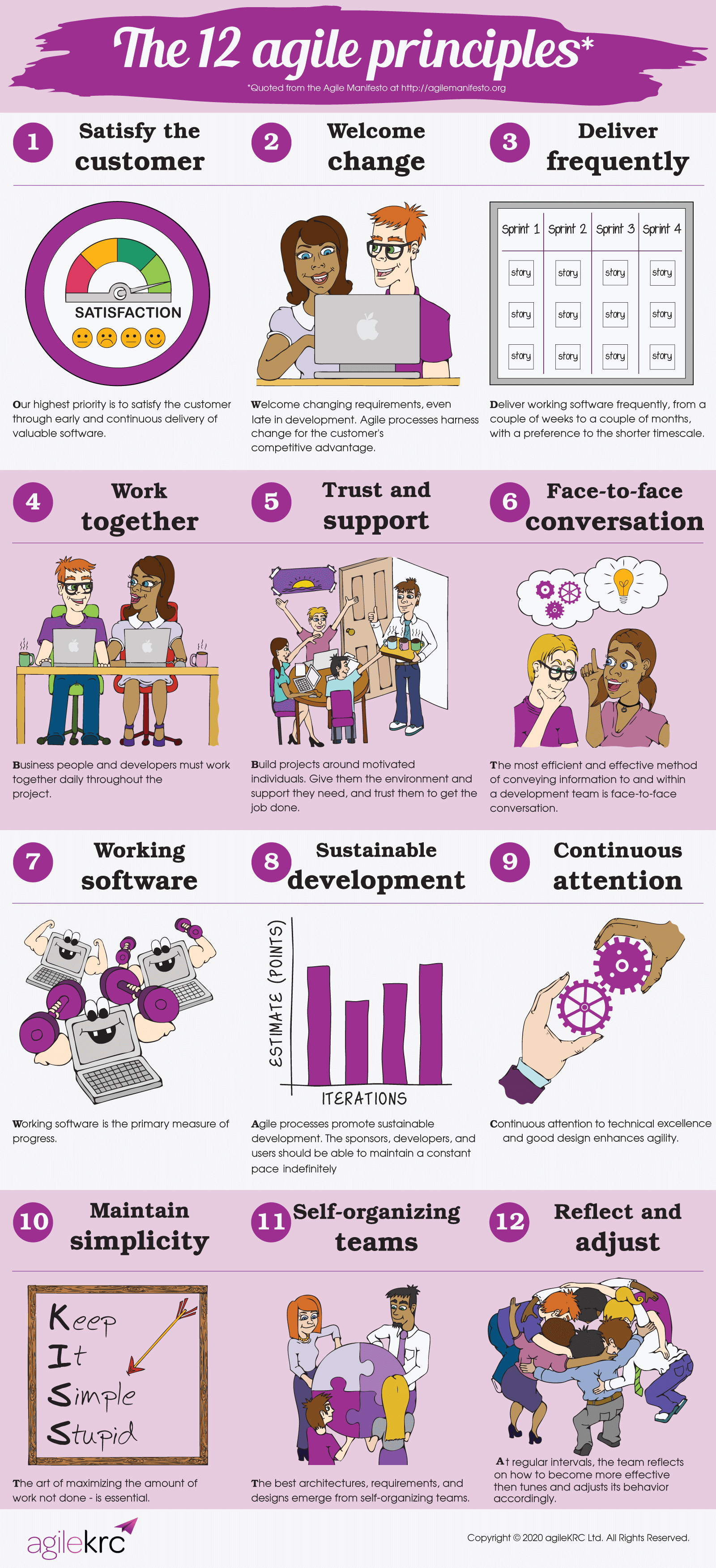
Agile Software Development – An Introduction
Agile has emerged as the premier software development paradigm, offering a set of 12 Agile Principles from the Agile Manifesto that drive the creation of high-quality software products in a quick and efficient manner.
Dissecting the principles
Serving as the foundation for the Agile methodology, the 12 Agile Principles dictate the actions and choices made throughout Agile projects. In this article, we will investigate these principles and their impact on Agile project delivery.
1. Our highest priority is to satisfy the customer through early and continuous delivery of valuable software.
The fundamental Agile principle is fixated on achieving customer contentment through the swift and sustained delivery of valuable software.
This principle highlights the need to establish a minimum viable product (MVP) that caters to customer preferences and can be developed within a brief time frame.
By supplying a working product promptly, customers can assess the software’s features and determine any necessary alterations. This guarantees that the final product aligns with customer needs and is delivered in a timely fashion.
2. Welcome changing requirements, even late in development. Agile processes harness change for the customer’s competitive advantage.
The second Agile principle urges teams to accommodate changing requirements, even as development nears completion.
This principle acknowledges the likelihood of requirements transforming during the development process, and the Agile methodology is built to be adaptable in response to these changes.
By cultivating a change-embracing attitude, the team can ensure that the completed product aligns with the customer’s evolving objectives.
3. Deliver working software frequently, from a couple of weeks to a couple of months, with a preference to the shorter timescale.
The third Agile principle highlights the importance of frequent delivery of working software, prioritising shorter timeframes.
This principle accentuates the need for consistent delivery of small, successive updates to the software, rather than holding off until the development cycle’s conclusion.
By adopting this technique, the team can ensure that the software is tested and validated at every step of the development process, mitigating the risk of hold-ups and mistakes.
4. Business people and developers must work together daily throughout the project.
The fourth Agile principle emphasises the necessity for consistent cooperation between customers and stakeholders for the duration of the project.
This principle highlights the importance of ongoing communication and feedback between the team members, the customer, and additional stakeholders.
By fostering close collaboration with the customer, the team can ensure that the software satisfies their requirements and anticipations, and by engaging stakeholders in the process, the team can ensure that the software addresses overarching business goals and objectives.
5. Build projects around motivated individuals. Give them the environment and support they need, and trust them to get the job done.
The fifth Agile principle advocates for the development of projects with driven individuals, offering them the required environment and support, and having confidence in their ability to complete the work.
This principle highlights the importance of fostering a supportive atmosphere where team members can work independently, take charge of their tasks, and cooperate efficiently with others.
By enabling individuals and trusting their judgement, the team can achieve enhanced results.
6. The most efficient and effective method of conveying information to and within a development team is face-to-face conversation.
The sixth Agile principle emphasises that face-to-face conversation is the most efficient and effective way of transmitting information to and within a development team.
This principle acknowledges the crucial role communication plays in all Agile approaches and asserts that direct, in-person communication is the premier method for sharing information, tackling challenges, and making decisions.
7. Working software is the primary measure of progress.
The seventh principle of Agile methods states that the foremost criterion for progress is the presence of working software.
This stresses the necessity of producing operational products at each phase of the development journey.
By evaluating progress based on the software’s functional capabilities, the team can ensure they are bringing value to the customer and accomplishing project milestones.
8. Agile processes promote sustainable development. The sponsors, developers, and users should be able to maintain a constant pace indefinitely.
In the context of Agile principles, the eighth tenet emphasises that sustainable development is promoted through Agile processes, and all stakeholders should be capable of maintaining a steady pace without end.
This tenet highlights the need for a sustainable development process, enabling the team to preserve a constant rate of work over an extended duration.
By circumventing long hours and burnout, the team can uphold high productivity and consistently produce high-calibre software over time.
9. Continuous attention to technical excellence and good design enhances agility.
In the context of Agile principles, the ninth tenet emphasises that constant dedication to technical excellence and sound design improves agility. This tenet accentuates the importance of technical proficiency and well-crafted design throughout the development process.
By directing attention to these factors, the team can ensure that the software remains maintainable, scalable, and resilient, thereby increasing its agility and ability to accommodate changing needs.
10. Simplicity – the art of maximising the amount of work not done – is essential.
Within Agile practices, the tenth guiding principle highlights that simplicity – the skill of maximising the amount of work not done – is vital.
This principle urges the team to pay attention to the essentials and sidestep superfluous tasks.
By lessening the work to be done, the team can minimise waste, optimise efficiency, and speed up product delivery.
11. The best architectures, requirements, and designs emerge from self-organising teams.
The eleventh Agile principle maintains that self-organising teams are the ultimate source of superior architectures, requirements, and designs.
This principle acknowledges the team’s expertise and knowledge in software development.
By fostering collaboration and allowing the team to make decisions, the team can devise exceptional solutions that cater to the customer’s needs.
12. At regular intervals, the team reflects on how to become more effective, then tunes and adjusts its behaviour accordingly.
The twelfth and final Agile principle advocates that at regular intervals, the team should reflect on how to become more effective and then adjust their behaviour accordingly.
This principle highlights the significance of continuous improvement and feedback in the development process.
By consistently assessing their performance and recognising areas for improvement, the team can elevate their efficiency, effectiveness, and overall quality of work.
Agile Principles: Key to Product Development Success
The 12 Agile principles play a vital role in guiding the product development process. They provide a framework for the entire process, ensuring that the team delivers a high-quality product that meets the customer’s needs. The principles guide every step, from planning and development to testing and delivery.
For example, the first principle highlights customer satisfaction through early and continuous delivery of valuable software. This principle guides the team to focus on delivering a minimum viable product that meets the customer’s requirements and can be delivered quickly. By doing so, the team can obtain feedback from the customer and adjust the product as necessary.
Similarly, the fourth principle emphasises collaboration with customers and stakeholders throughout the project. This principle guides the team to involve them in the development process, ensuring that the product meets their needs and aligns with broader business objectives.
The sixth principle highlights face-to-face conversation as the most efficient and effective way of conveying information within the development team. The team prioritises face-to-face communication to ensure that information is shared effectively, and issues are resolved quickly.
The twelfth principle emphasises the team’s continuous improvement efforts. The team regularly evaluates its performance, identifies areas for improvement, and adjusts its behaviour to enhance its efficiency, effectiveness, and overall quality of work.
Summary
The Agile principles enable sustainable development by providing a comprehensive framework for delivering high-quality software that meets the customer’s needs and aligns with business objectives. Collaboration, communication, feedback, and continuous improvement are the foundational principles of Agile, empowering teams to enhance their productivity, agility, and overall effectiveness.
The Agile principles also stress the importance of adaptability and flexibility in today’s fast-changing business landscape. By prioritising customer satisfaction, early and continuous delivery, and a rapid response to change, Agile teams can create solutions that are sustainable, meeting evolving needs and delivering real value to customers and the broader business.
The Agile principles guide all Agile approaches and methods, informing every stage of the Agile development process. These principles emphasise collaboration, communication, feedback, and continuous improvement, which are essential for creating high-quality software that meets customer needs and adapts to changing requirements.
By following these principles, Agile teams can enhance their productivity, agility, and overall effectiveness and enable sustainable development by creating solutions that provide tangible benefits to the customer and the broader business.
agileKRC has helped shape agile thinking by leading the teams that developed AgilePM® and PRINCE2 Agile®. We take a practical, success-oriented approach. We begin by taking the time to listen and understand your needs, before offering our real-world experience and expert guidance.














